The modern smart home has transformed how we interact with our living spaces, bringing convenience, efficiency, and automation to everyday tasks. As this transformation continues, one area seeing remarkable innovation is the integration of swimming pools into wider home automation ecosystems. No longer isolated systems requiring separate management, today's smart pool controllers can seamlessly connect with your home automation platform, creating a unified experience that enhances both convenience and functionality.
The Evolution of Pool Automation Integration
Pool automation itself isn't new—controllers that manage basic functions like pump scheduling and heating have been around for decades. However, what has changed dramatically is how these systems communicate with other smart home technologies.
From Isolated Systems to Connected Ecosystems
Traditionally, pool automation systems operated as standalone units with proprietary interfaces. Even as they added remote control capabilities through dedicated apps, they remained isolated from the broader smart home ecosystem. This separation meant pool owners needed to juggle multiple apps and interfaces to manage their home environment.
The landscape began shifting around 2018 when major pool equipment manufacturers started developing voice assistant integrations. Today, we've reached a tipping point where comprehensive integration with home automation platforms has become not just possible but increasingly seamless.
The Matter Protocol: A Game-Changer for Integration
One of the most significant developments in 2025 for smart home interoperability is the Matter protocol, an industry-standard connectivity protocol that enables smart home devices from different manufacturers to work together reliably.
While Matter wasn't initially designed with pool systems in mind, its expanding device categories and growing adoption have begun to influence how pool controllers interact with other smart home devices. This standardization is gradually reducing the proprietary barriers that have historically limited pool automation integration.
Compatibility Guide: Major Pool Controllers and Home Automation Systems
Before diving into integration specifics, it's essential to understand which pool automation systems work with various home automation platforms. Here's a breakdown of the major players and their compatibility in 2025:
Pentair Systems
Pentair offers several automation options with varying levels of smart home integration:
-
IntelliCenter: Pentair's flagship system offers the most comprehensive integration capabilities, including compatibility with:
- Amazon Alexa
- Google Home
- Apple HomeKit (in select regions)
- SmartThings
- Control4
-
EasyTouch: This mid-range system supports:
- Amazon Alexa (via ScreenLogic interface)
- Google Home (limited functionality)
- Limited third-party platform integration
-
IntelliConnect: The entry-level option provides:
- Basic Alexa and Google Home integration
- Limited functionality compared to higher-end models
Pentair's systems are generally known for their strong integration capabilities, particularly with voice assistants like Amazon Alexa.
Hayward Systems
Hayward has made significant strides in smart home integration:
-
OmniLogic: Hayward's premium controller integrates with:
- Amazon Alexa
- Google Assistant
- SmartThings
- Control4, Crestron, Elan, and RTI (for advanced home automation)
- Nest thermostats
-
OmniHub: This more affordable option offers:
- Same voice assistant integration as OmniLogic
- More limited support for advanced home automation platforms
Hayward has particularly focused on voice control functionality in recent years, with robust command options through voice assistants.
Jandy Systems
Jandy's approach to integration has focused primarily on their own ecosystem, but with increasing third-party support:
-
AquaLink RS: Jandy's main control system offers:
- Amazon Alexa integration
- Google Home (with more limited functionality)
- Limited third-party platform compatibility
-
iQPUMP01: This dedicated pump controller works with:
- iAquaLink app only (no direct smart home integration)
Jandy has been somewhat more conservative with third-party integration but has improved its voice assistant compatibility in recent updates.
Third-Party and DIY Controllers
Several third-party and DIY options offer interesting alternatives for integration-focused pool owners:
- Home Assistant Pool Components: Open-source options for comprehensive integration
- NodeRed Pool Controllers: Customizable solutions for technically-inclined users
- Z-Wave Relay Controllers: Solutions for retrofitting existing equipment
For users comfortable with technical tinkering, these options can sometimes provide even deeper integration than proprietary systems.
Integration Methods: From Basic to Advanced
The way you integrate your pool controller with your home automation system can vary significantly based on your technical comfort level and desired outcome. Here are the primary approaches, from simplest to most complex:
Method 1: Voice Assistant Integration
The simplest integration method uses voice assistants as an intermediary between your pool system and other smart home devices.
Setup Process:
- Ensure your pool controller supports your preferred voice assistant
- Install the relevant skill/action for your pool system:
- For Alexa: Enable the appropriate skill (e.g., "Pentair ScreenLogic" or "Hayward OmniLogic")
- For Google: Link your pool account in Google Home
- Discover devices through the assistant app
- Create voice commands for common pool functions
Example Commands:
- "Alexa, ask Hayward to turn on my pool lights"
- "Hey Google, set my pool temperature to 82 degrees"
- "Alexa, tell Pentair to turn on the spa"
This approach is ideal for users seeking basic integration without technical complexity.
Method 2: Smart Home Platform Direct Integration
A more comprehensive approach connects your pool controller directly to your smart home platform.
Setup Process for Popular Platforms:
SmartThings:
- Ensure your controller is SmartThings-compatible
- Add the device through the SmartThings app
- Install any relevant device handlers if needed
- Create automations that include pool functions
Apple HomeKit:
- Verify HomeKit support (primarily available with Pentair systems)
- Scan the HomeKit code or manually add the device
- Organize your pool devices into the appropriate room
- Set up scenes that incorporate pool functions
This method provides deeper integration, allowing pool functions to be included in scenes and routines alongside other smart home devices.
Method 3: Hub-Based Integration Through APIs
For advanced users, API-based integration can provide the most flexibility and control.
Setup Process:
- Choose a compatible home automation hub (Home Assistant, Hubitat, etc.)
- Install the appropriate integration module for your pool controller
- Configure API connections following manufacturer documentation
- Create advanced automations leveraging detailed pool data
- Optionally, use webhook or MQTT integration for real-time data
This approach requires technical knowledge but provides the deepest level of integration and customization.
Creating Powerful Pool Automation Scenarios
Once integrated, the real power comes from creating scenarios that combine pool functionality with other home systems. Here are some compelling examples:
Entertainment Modes
Create comprehensive entertainment scenes that coordinate pool features with other home elements:
"Evening Swim" Scene:
- Sets pool lights to a relaxing blue color
- Turns on landscape lighting around the pool area
- Starts playing music on outdoor speakers
- Adjusts pool temperature to comfortable swimming levels
Implementation Tip: Use your home automation platform's scene or routine function to trigger multiple actions with a single command or schedule.
Weather-Responsive Automation
Use weather data to intelligently manage your pool:
Storm Protection:
- When weather service predicts high winds, automatically lowers water features
- Sends notification to close pool cover if rain is forecasted
Temperature Optimization:
- Adjusts heating schedule based on outdoor temperature forecast
- Reduces chemical dispensing before heavy rain
Implementation Tip: Most advanced home automation platforms can connect to weather services and use weather data as triggers for automations.
Energy Management
Coordinate pool energy usage with whole-home energy systems:
Solar Synchronization:
- Runs pool pump at higher speeds when solar production is at its peak
- Adjusts heating based on solar energy availability
Utility Rate Response:
- Shifts intensive pool operations to off-peak hours
- Temporarily reduces pool energy consumption during utility demand response events
Implementation Tip: For solar users, consider integration with energy monitoring systems to optimize pool power usage around solar production.
Multi-Trigger Safety Features
Enhance pool safety with sensor integration:
Child Safety:
- Automatically turns off water features when gate sensors detect pool access by unaccompanied children
- Sends alerts to homeowner mobile devices when pool area is accessed unexpectedly
Freeze Protection:
- Activates appropriate equipment when temperatures approach freezing
- Sends confirmation alerts when freeze protection engages
Implementation Tip: Combine multiple sensor types (motion, contact, temperature) for comprehensive safety coverage.
Overcoming Common Integration Challenges
While integration has become easier, several challenges remain. Here's how to address the most common issues:
Limited Native Compatibility
Challenge: Your pool controller doesn't officially support your home automation platform.
Solution: Consider these workarounds:
- Use voice assistants as a bridge between systems
- Explore community-developed integrations
- Add smart relays to control pool equipment directly
- Investigate middleware solutions that translate between protocols
Network Reliability Issues
Challenge: Pool equipment is often located far from home network access points, resulting in weak connections.
Solution:
- Install mesh network systems or Wi-Fi extenders to strengthen coverage
- Consider wired Ethernet connections for critical controllers
- Place controllers in locations with optimal signal
- Use external antennas where supported
Visit our guide to Optimizing Your Outdoor Network for more detailed recommendations.
Firmware and Software Compatibility
Challenge: Software updates can sometimes break integrations or change functionality.
Solution:
- Check community forums before updating critical components
- Document your working configuration before updates
- Consider delaying updates until compatibility is confirmed
- Maintain backup configurations where possible
Security Considerations
Challenge: Adding pool systems to your home network creates additional potential security vulnerabilities.
Solution:
- Use strong, unique passwords for all pool control accounts
- Place pool controllers on a separate network segment where possible
- Keep firmware updated on all components
- Review and limit the permissions granted to integration services
Looking Forward: The Future of Pool and Home Integration
As we move through 2025 and beyond, several emerging trends are shaping the future of pool and home integration:
Matter Protocol Expansion
The Matter smart home protocol continues to expand its device categories, with pool systems gradually being incorporated. This standardization promises to significantly simplify integration in coming years, reducing the complexity of connecting different brands and platforms.
As implementation reaches critical mass, we can expect unified setup processes and more reliable communication between devices across brands.
AI-Enhanced Pool Management
Artificial intelligence is beginning to transform pool management, with systems that can:
- Learn user preferences and anticipate needs
- Optimize energy usage based on historical patterns
- Predict maintenance requirements before issues arise
- Make intelligent adjustments based on actual usage patterns
These AI capabilities will become increasingly integrated with whole-home management systems, creating truly intelligent environments.
Increased Data Sharing Between Systems
The next generation of integration will feature richer data sharing between pool systems and other home components:
- Energy management systems will incorporate detailed pool energy usage
- Water management systems will coordinate pool water needs with irrigation
- Environmental controls will factor pool conditions into whole-home comfort management
This deeper data integration will enable more sophisticated and efficient whole-property management.
Conclusion: Building Your Integrated Pool Experience
Integrating your pool controller with your home automation system represents one of the most significant enhancements you can make to your swimming pool experience. From basic convenience features to sophisticated multi-system automations, the possibilities continue to expand as technology evolves.
For most pool owners, the journey to integration is best approached incrementally:
- Start with voice control as a simple entry point
- Explore direct platform integration for greater functionality
- Add complementary sensors and devices to enhance automation possibilities
- Gradually implement more advanced scenarios as you become comfortable with the system
By thoughtfully integrating your pool into your broader smart home ecosystem, you'll not only enhance convenience but also potentially improve efficiency, safety, and enjoyment of your aquatic environment.




Leave a comment
This site is protected by hCaptcha and the hCaptcha Privacy Policy and Terms of Service apply.